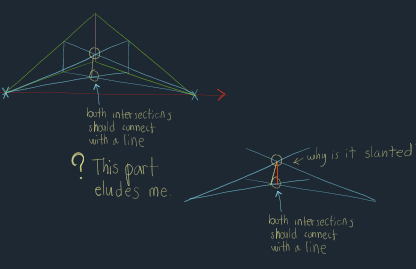04-23-2021, 08:31 AM
Zizka, regarding the tops and bottoms of the cylinders, I could try to explain, but I think it would be more helpful for you to find some pictures of cylindrical objects (or observe them in real life) from various angles and trace them. In a perfect cylinder, the connecting lines will appear wherever they make a clean angle with the frontal face of the cylinder (as opposed to intersecting it in a perpendicular fashion). Which I think is the same spot as the far ends of the major axis, or greatest diameter of the ellipse. (Anyone, feel free to correct if that's wrong.)
Regarding that 2PP drawing in the bottom left. I don't think it's actually off (not significantly, anyway), it just looks weird because it's rectangular rather than square. Regarding that slanted line, I don't think it's actually that slanted; I attached an image where I think it could be drawn straight while still being in the intersection of those lines. It just looks that way because of the very small brush size, leading to pixel-level distortions. Any actual slantedness is most likely due to you being VERY slightly off when making lines with the line tool, which can be hard to avoid. Is that image you posted at the actual resolution you work at? If so, I suggest working at a bigger resolution to minimize confusion.

Regarding that 2PP drawing in the bottom left. I don't think it's actually off (not significantly, anyway), it just looks weird because it's rectangular rather than square. Regarding that slanted line, I don't think it's actually that slanted; I attached an image where I think it could be drawn straight while still being in the intersection of those lines. It just looks that way because of the very small brush size, leading to pixel-level distortions. Any actual slantedness is most likely due to you being VERY slightly off when making lines with the line tool, which can be hard to avoid. Is that image you posted at the actual resolution you work at? If so, I suggest working at a bigger resolution to minimize confusion.









![[Image: qPoR051.png]](https://i.imgur.com/qPoR051.png)


![[Image: hKOE5uQ.png]](https://i.imgur.com/hKOE5uQ.png)
![[Image: Ige7GIC.png]](https://i.imgur.com/Ige7GIC.png)
![[Image: 6rzXo6M.png]](https://i.imgur.com/6rzXo6M.png)
![[Image: IVhElNv.png]](https://i.imgur.com/IVhElNv.png)
![[Image: 2ULZrKY.png]](https://i.imgur.com/2ULZrKY.png)
![[Image: YgOtSa4.png]](https://i.imgur.com/YgOtSa4.png)
![[Image: 6bjoM2N.png]](https://i.imgur.com/6bjoM2N.png)
![[Image: Hxmx1Il.png]](https://i.imgur.com/Hxmx1Il.png)
![[Image: Xvk8byl.png]](https://i.imgur.com/Xvk8byl.png)
![[Image: DMkg76P.jpg]](https://i.imgur.com/DMkg76P.jpg)